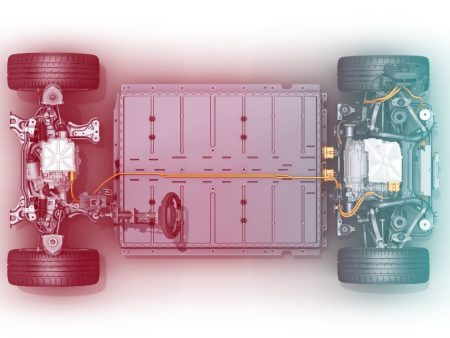EV Car Cooling System
완벽한 온도 제어 솔루션을 위해 지금 바로 문의하세요.
The ev car cooling system mainly blows the coolant (a mixture of coolant and air) to the cooling unit through the rotation of the fan, and then the coolant in the coolant undergoes a certain degree of chemical reaction, causing the coolant to mix with the air. To achieve the purpose of cooling the battery module.
How does the EV car cooling system work?
The air-conditioning compressor of electric vehicles is an electric compressor, which is driven by high-voltage electricity (its rotation speed can be actively adjusted by the air-conditioning system, and its adjustment range is 0 ~ 4000r/min). The high-temperature and high-pressure refrigerant vapor discharged by the compressor passes through The high-pressure hose enters the condenser of the air conditioner. Since the temperature of the high-temperature and high-pressure refrigerant vapor is higher than the temperature of the air outside the car, the heat of the refrigerant vapor in the condenser is taken away by the air outside the car with the help of the condenser fan, so that the high-temperature and high-pressure refrigerant vapor condenses into higher temperature High pressure liquid.
It flows into the drying reservoir through a high-pressure hose. After drying and filtering, it flows through the expansion valve. Under the throttling effect of the expansion valve, the refrigerant turns into a low-temperature and low-pressure liquid and enters the evaporator of the car air conditioner. It vaporizes under a constant pressure and absorbs the heat in the air outside the evaporator tube, thereby circulating the inside of the car through the evaporator. The temperature of the air is reduced to cold air, which is sent into the car through the blower to reduce the air temperature inside the car.
The vaporized refrigerant vapor is sucked and compressed by the compressor, and turns into high-temperature and high-pressure refrigerant gas. It is pressed into the condenser of the automobile air conditioner through the high-pressure hose, completing a refrigeration cycle of the automobile air conditioner.

Introduction to the characteristics of ev car cooling system
EV car cooling system is mainly composed of four parts: power battery, cooling device, fan and control system. The cooling device consists of a coolant circulation system and a radiator. The heat dissipation efficiency of the cooling device determines the overall heat dissipation efficiency of the electric vehicle. The coolant circulation system can be divided into the following two types: one is water-cooled type, and the other is air-cooled type.
The water-cooled cooling system has a simple structure, good heat dissipation performance, but has a complex structure, high cost, and large volume; the air-cooled cooling system has a simple structure, low cost, and small volume, but its heat dissipation performance is not as good as the water-cooled cooling system.
Based on the above analysis, it can be seen that the structural design of the liquid cooling system of electric vehicles must take into account the following aspects: 1) The thermal impact of the coolant on the battery module; 2) The coolant circulation pump; 3) The fan and control system. Only by fully considering these aspects can a more reasonable EV car cooling system be designed.
Thermal impact of coolant on the battery module: The coolant in the cooling system has a certain thermal impact on the battery module, which is mainly manifested in:
1. The heat dissipation capacity of the battery decreases as the temperature increases. The higher the temperature, the worse the heat dissipation capacity. However, if the cooling effect of the coolant in the cooling system is not good, the battery module will overheat, and in severe cases, it may even cause the battery to burn.
2. When the battery module operates in a high temperature environment, the internal resistance of the battery will increase, which will intensify the heating of the battery module. Therefore, attention should be paid to the heat dissipation design of the battery module in the cooling system.
3. In some special circumstances, if the coolant temperature is too high, the temperature inside the battery module will be too high, leading to thermal runaway. At this time, the coolant needs to be cooled down, otherwise thermal runaway may occur. Therefore, when designing the cooling system, special attention should be paid to the impact of the coolant on the battery module, especially to prevent thermal runaway.
As the main representative of new energy vehicles, electric vehicles are becoming more and more mature in technology and play a very important role in environmental protection and sustainable development. Therefore, it is very necessary to study the cooling system of electric vehicles.
Through collaborative analysis of the thermal flow field of electric vehicle cooling systems and research on key liquid cooling technologies, the level of thermal management in electric vehicle cooling systems can be improved, which is of great significance to improving the safety and economy of new energy vehicles.
완벽한 온도 제어 시스템 설계 및 제조를 제공합니다. 표준 모델부터 완벽한 맞춤형 제품까지 900 . 당사는 고객 서비스를 전문으로 하며 각 고객이 특정 요구에 맞는 최적의 온도 제어 시스템을 갖출 수 있도록 최선을 다하고 있습니다.
비표준 맞춤형 솔루션을 제공합니다. 단일 냉각 냉각기와 냉각 및 난방 콤보 장치를 모두 사용할 수 있습니다.
이메일: info@lneya.com WeChat ID: +8615251628237 WhatsApp: +86 17851209193
 LNEYA
LNEYA
 简体中文
简体中文


















































































